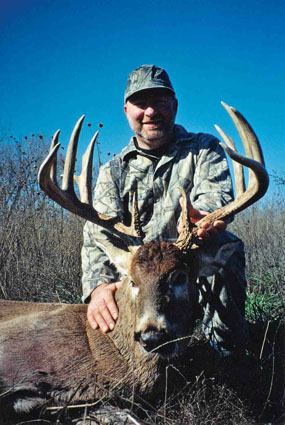 On December 30 a few seasons back, my phone rang and I answered it to find an excited bowhunter on the other end. Melvin Hart was itching to tell me of his plan for the next morning to harvest the big buck he had patterned. “I think I’ve got this buck figured out,” he said with excitement. “I’ve watched him from a distance the last few days, and he enters and exits a large wheat field in the same place every time. I plan on being there early in the morning.”
On December 30 a few seasons back, my phone rang and I answered it to find an excited bowhunter on the other end. Melvin Hart was itching to tell me of his plan for the next morning to harvest the big buck he had patterned. “I think I’ve got this buck figured out,” he said with excitement. “I’ve watched him from a distance the last few days, and he enters and exits a large wheat field in the same place every time. I plan on being there early in the morning.”
I hung up the phone thinking that if anybody could pull off a ground ambush, it was Hart. An auto mechanic and taxidermist by trade, with several big bow bucks to his credit, Hart had learned that being adaptable has enabled him to put some nice bucks on the wall. With several P&Y whitetails and nearly a dozen P&Y elk to his credit, the soft-spoken Hart lives to hunt.
Hart hunts trophy bucks only, and making the quest tougher is the fact that Hart hunts almost exclusively at ground level, having given up his tree stand in 1987 to, as he puts it, “hunt bucks on an equal footing.” He explains the reasons why he prefers this style of hunting: “It allows me to be flexible and stalk game that I normally would never have an opportunity to harvest. And I believe it is a more challenging way to hunt, and I like to challenge myself.”
Though he’s taken several trophy-class animals, Hart isn’t obsessed with record-book notoriety. In fact, Hart declined to enter most of his prize whitetails in the record books. “Unless I take an animal in the Top 10,” he says, “I don’t feel it’s worthy of recognition.”
Hart says big bucks prefer open country because they feel safer due to their ability to see farther, and he believes that many big bucks grow old and die in such wide-open spaces, unseen by most hunters. For these reasons, he prefers to hunt the unbroken expanses of western and northwestern Oklahoma — windswept prairie areas that are the home grounds to monster whitetails and mule deer overlooked by many hunters.
The last day of Oklahoma’s bow season dawned to sub-freezing temperatures that were accompanied by a howling north wind. Hart arrived at his hunting spot at 3 a.m., knowing that he would have to make a long approach involving nearly a 3-mile walk to arrive at his ambush spot undetected, and to avoid trespassing on land he didn’t have permission to cross.
Arriving at his ambush spot an hour before daylight — tall-grass prairie bordering a huge wheat field — Hart huddled within the confines of the tall grass. He methodically glassed the wheat field as the horizon was gradually illuminated by the dawn light.
As expected, several does were already feeding in the field, and soon Hart spotted the buck he was after. The buck was a main-frame 10-pointer with nearly a 24-inch spread. Content after gorging themselves on the high-protein wheat, the does headed off the field to a thick bedding area nearly a mile away. The big buck followed.
Hart remained motionless as the does walked by 30 yards away, taking turns to effortlessly jump over a barbed-wire fence. The buck lagged behind and soon offered Hart a shot as he neared the fence. Already at full draw, Hart released and watched as his fletching disappeared behind the buck’s shoulder.
After following a short, well-marked blood trail, Hart stood over that season’s best buck — a 170-inch (gross), typical 11-point. Previously, the savvy archer had arrowed a 150-inch 8-pointer after stalking within close range of the unsuspecting buck. Taking two P&Y whitetails in one season isn’t bad for an archer, whether hunting in a tree stand or on the ground.






